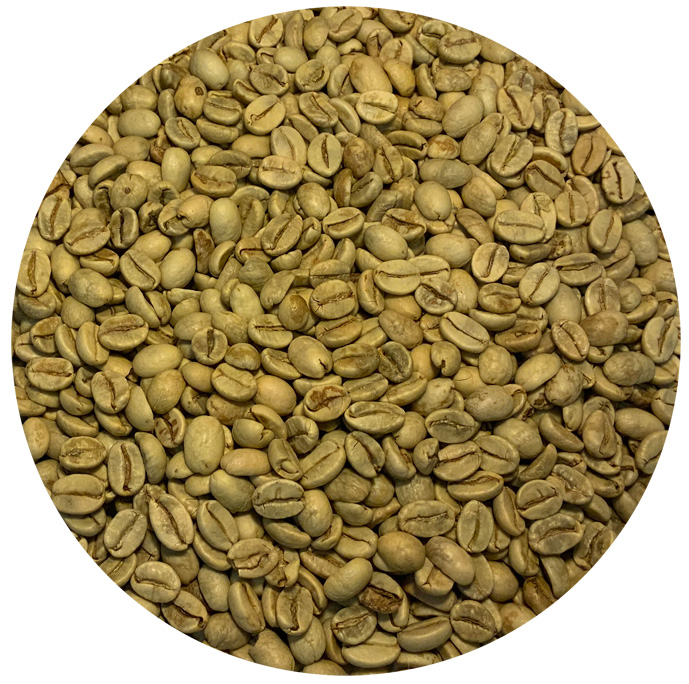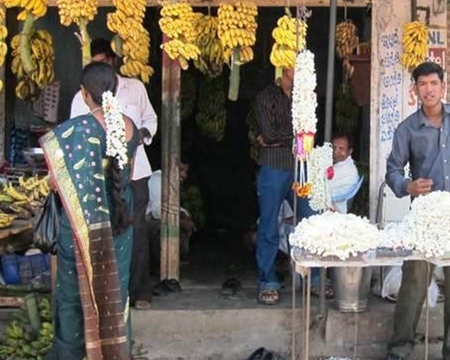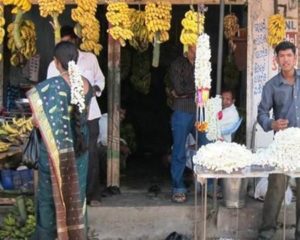Description
The Indian Monsooned Malabar is a very unique and exotic coffee; usually people have a love/hate relationship with this bean but it is one of our top sellers year in and year out.
Monsoon Malabar coffee is prepared from Arabica cherries (“cherry” refers to dry-processed coffees in India). After grading, the coffee is transported to the coastal city of Mangalore where the “monsooning” is carried out in large openwalled warehouses.
During the rainy months of June through August, the coffee is spread inside the warehouses with very good aeration and ventilation at a particular thickness so that the coffee slowly absorbs moisture. After it absorbs sufficient moisture and bloats in size, it has to be periodically bulked and bagged and stacked so as to ensure proper and uniform “monsooning.” This process has to be carried out many times during the months of the monsoon.
After September, when the rains subside and the temperatures are higher, the ghostly white and swollen beans are sent through the final grading (gravity tables and hand-sorting) in order to obtain the Malabar export quality. The farmers not only produce coffee, they also grow pepper, cardamom, and oranges. Most of the farms are 80 to 100 years old and belong to third generation growers.
Tasting Notes:
The Indian Monsooned Malabar is a very low acidity, thick and creamy, overly earthy style cup of coffee. There is a lot of sweet tones in this cup depending on the roast and one can taste a little hint of the natural processing soft fruit tones and classic Indian spice notes. A pretty wild cup for you stronger coffee fans or espresso heads.
Roasting Notes:
Usually used for espresso at the darker roast points but many of our customers enjoy the single origin drip brew or french press at a slightly lighter roast point.





















SF Bill –
Love/hate, ghostly white, swollen beans. Wow, the Burman description hits it right on the head. I was intrigued by all this and ordered some for espresso. The beans were huge but had the least density of any unroasted bean I ever saw. Despite that I was surprised by how long it took to roast to full city, perhaps 2-3 minutes more on my SR-500. The taste as S.O. was kind of weird, almost moldy but had some of the best crema I’ve seen and blended nicely with pretty much anything else. I don’t know if I’m sophisticated enough to order it again but I’m glad I tried it as something out of the ordinary. BTW, the decaf Monsooned Malabar when available tastes much more like a normal coffee .
Jon Burman –
Indian Monsooned Malabar is one unique bean. In air roasters like the SR 500, they will take longer to roast due to them being less dense. Air roasters work by trapping heat, less dense beans trap less heat.
Luckily we carry decent grades of Monsooned Malabar, no mold on these beans but the taste is very complex earthy and herbal with some sweet tones upfront, very thick.
The number one use of Monsooned is for espresso blends – many do enjoy it as a single origin drinker but it will be an acquired taste. Will definitely raise crema and body in any espresso blend.
A. L. (verified owner) –
I was really excited to try this, yet apprehensive at the same time based on the description and unique smell when my order arrived. I had ordered 5 lbs of this as part of a 40 lb mixed order. The entire box smelled like Monsooned Malabar. My wife immediately commented on the color as compared to what she was used to seeing (straw vs. green). I roasted 375g in the Behmor 1600 (Profile: P1, Program: A, 1lb). Hit 1st crack at 15:55 and as it wound down around 17:50, the sound began to change, gradually at first, then very rapidly and distinctly to what sounded like 2nd crack. Ended the roast at 18:18, pretty concerned that I blew it on this first batch. I had been aiming for just after 1st crack. Final weight was 320g. Not entirely sure what I created, but the coffee tastes great! Very complex flavor and low acidity; definitely stays on the palate for a very long time.
K. Myers –
A must try for anyone getting into home roasting. I am partial to coffees that have chocolate and nut tones so the fact that I recommend this one is saying something. The thick and earthy qualities are the draw here. The spice, fruit and aromas are very nice. Complex but not overly so at the darker roasts. I think the low acidity takes some of the edge off as well. Using the SR500, I go at least 2 minuets into second crack, just enough to see a little sheen on the surface when you are finished. Prefer using the AeroPress for this one but great results with the Chemex and French Press as well.
I agree with a previous review about the decaf version being less complex. Able to please a crowd and great for after dinner desert or a late night snack.
Edenfantasys –
The origins of Monsoon Malabar date back to the times of the British Raj, when, during the months that the beans were transported by sea from India to Europe, the humidity and the sea winds combined to cause the coffee to ripen from the fresh green to a more aged pale yellow.
Kelley (verified owner) –
My first experience with monsooned Malabar was a gift from a friend in Germany. It was already roasted, but fresh. I used it to make a couple of pour overs and it bloomed very nicely. It was a bit dark, but surprisingly very good. I just roasted a pound in my 1600+ Behmor using 1#, P2, D and added 1 minute. I’ve roasted the decaf version as well, but prefer this very nice, versatile bean.
Chris L (verified owner) –
This is a great coffee for those starting home roasting. The beans start circulating almost immediately after the roaster is turned on thus avoiding burned beans at the bottom. These beans create almost no smoke and very little chaff. They also go gradually from one roasting phase to the next. I roast it 8-9 minutes in my FB-101DG. I make one batch Full City Roast and the second Light Vienna Roast. I mix the two batches together, let them sit for 2 days, and have a good cup. I sometimes bring this combination as a gift to the hosts when we dine at friends’ homes. They always ask for more.
Susan –
I was intrigued the first time I ran across Monsooned Malabar in a shop in London, where it was roasted to at least FC+. It easily overcame the aromas of everything else. As with batches I have bought from Burman over the years (which quality is pretty darn good and consistent overall), The profile is definitely “Earthy,” in a wet camel meets exotic marketplace kind of way, almost moldy and organic but not quite, funky and exotic while enjoyable. There is usually really heavy body, a hint of super ripe fruit and maybe a hint of gym socks, but if you like it, you REALLY like it. I like it about once a year, so I give it 4 stars.
rdcampos (verified owner) –
This is my ‘go to’ coffee!!! I have been ordering from the Burman’s for many many years. I don’t remember why I tried it but I sure am glad I did!!! I roast it, just past 2nd crack. Low acid, great mouth feel and a wonderful aroma, very low chaff. Don’t get me wrong, I love to try new beans but if I know I am going to have a rough week, I will roast the monsooned on Sunday.
OlyPenAaron (verified owner) –
I, too, am one of the fortunate ones who received this coffee in a sampler pack a few years back as I was learning my way around the Behmor 1600. I take it just into 2nd crack, hit the cooling cycle, and find that’s a great point that blends the roast level I most enjoy, and the unique (already noted by others – better than me) elements of the bean. Just awesome!
Katelyn Jenkins (verified owner) –
Read somewhere else this coffee was an “acquired taste”, something that “espresso aficionados should try”, and “if you like it, you’d really like it, or if you don’t, you don’t”. With that kind of introduction, I couldn’t resist, but at the same time, as apprehensive as could be. Overall, I was amazingly excited to receive these beans.
[Arrival] Monsoon Malabar beans smell amazing, and not much different from any other processing method and/or origin. These have a slightly lower density and are slightly bigger than what’s typical, and arrived in a larger bag. The beans are a lighter green verging on yellow, with a few bites speckles and moldy-looking green spots. All is well at this point!
[Roasting] When using the cast iron skillet method, keep in mind these beans are stickier, just by little/significant amount, than any others you may have tried; make sure to keep an eye out for uneven roasting as these are as difficult to get an even roast… go slow on it. Went to a medium, city (though I wish I had gone a little lighter!).
[Brewing] As for the aroma of the brewed coffee: musty and vegetal. Consistency: smooth. Taste: spice, earthy, bittersweet chocolate.
[Overall] This coffee is super unique and is an experience indeed, and would recommend. I’m very sure this shouldn’t be a coffee with partiality towards it; for comparison, it tastes close to a Papua New Guinea — definitely not mild, but wild!
Dhelsel (verified owner) –
I initially tried this bean based on the reviews and its apparent uniqueness, and Ii turned out to be a good decision!
However, while most folks liked it best darker (into 2nd crack), my favorite roast point was a more city roast. The earthiness of the bean really grew on me, and keeping it more med-roast really brought those notes out. This has become one of my favorite beans.
I’m roasting with an aillio bullet, and taking it just past first crack (this bean starts first crack later than most on my roaster, so temp is already pretty high.)
Tim Allen (verified owner) –
I got into roasting back in 2016; I use an open flame manual crank roster that was fabricated to replicate an 1800’s style roaster. Indian Monsooned malabar is by far my favorite bean so far, albeit I don’t buy beans above $7/lb. I haven’t had it for quite a a while (hence today’s visit), but I’m greatly looking forward to it. I can’t talk the fancy mechanical roaster talk, but for a country boy like me here’s what I say- this coffee tastes fantastic and it stands out from the rest. I like it solo and mixed. Don’t be scared, try it. Or don’t and leave more for us to buy.
Andi (verified owner) –
^^^ What he said.
Roshan –
These are fantastic and unique beans and anybody I roast them for always ends up adding this to their rotation. I can never found enough of this stuff
UrDad (verified owner) –
regardless of the processing method of these beans, don’t not try them. You will like.
Bradley Lagers (verified owner) –
I started home roasting six months ago when I couldn’t get these beans fast enough. I’ve been making espresso for a couple years with reasonable success. But these beans are amazing for espresso. My daughter who never liked black coffee now loves straight espresso, and I even let my granddaughters age six and seven take a little sip. They both liked it.
Daniel Worster –
Absolutely love this coffee! Roast to medium to dark in SR800. Lovely earthy taste. My sister also loved it!
Chris (verified owner) –
Roasted it to a City roast in a behmor, holy heck, a lot better than the first time I tried Monsooned Malabar like 5 years ago. Very syrupy body super creamy and thick, slight woody almost almond like note, dark chocolate, and slight malty notes. No acidity at all. Super smooth coffee, amazing for people who have acid issues from coffee or like to have smoother coffee beans. Also pairs really good with sweet foods.